Costa Del Sol Beaches
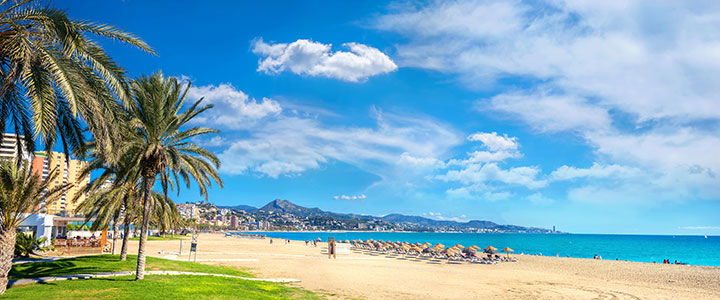
Beaches in the Málaga province
The Costa del Sol beaches, all bathed by the warm waters of the Mediterranean sea, are one of the biggest tourist attractions in the south of Spain. An extensive coastline that goes from Nerja to Manilva, where the sun shines most of the year.
They vary from long sandy beaches that invite you to take long walks along the shore, small coves ideal for spending a more private and relaxing day, to urban beaches where you can enjoy all kinds of amenities and comforts.
We have broken these down into six main areas. Should you have any additional questions you can come and chat with us and thousands of others on our Facebook Page and join our Costa Del Sol Travel Forum.
- Nerja
- Malaga
- Fuengirola
- Marbella
- Estepona
- Manilva
Nerja beaches
Nerja’s beaches are characterized by being surrounded by cliffs and are well known for their crystal-clear waters. Nerja is the municipality with the largest number of wild beaches, ideal for those seeking to be in contact with nature. Its paradisiacal coves and beaches make up 13 kilometres of coastline and are ideal to relax or practice water sports.
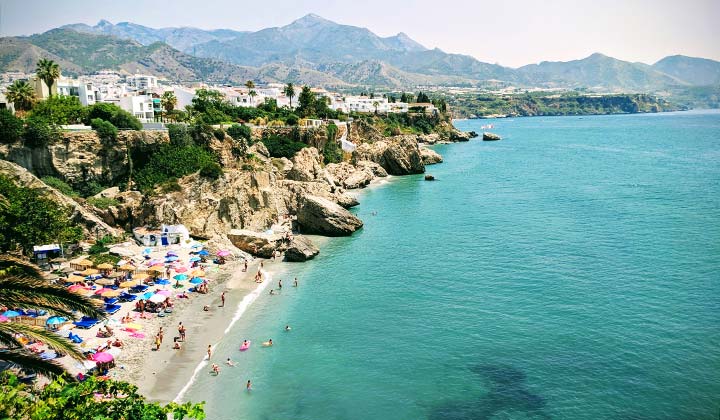
Málaga beaches
Málaga’s beaches enjoy the privilege of being all within walking distance from the city centre, and with all the services and attractions that this entails. In total, the city has 14 kilometres of beaches, all well connected and equipped with all kinds of high-quality services.
A network of promenades usually separates the beaches from urban traffic making Málaga beaches a haven of peace. Here you’ll be able to relax sunbathing, practice all kinds of water sports and enjoy the great variety of bars and beach restaurants.
Fuengirola beaches
Fuengirola has the longest promenade in Spain, ideal for a pleasant stroll at sunset, surrounded by palm trees, flowers, and benches to rest after a long walk. Its seven main beaches, which have all the necessary requirements to spend a great summer day, where beach bars, water activities, sand sculptures, and sun loungers attract many tourists from all over the world.
Marbella beaches
Since the 1950s, Marbella’s beaches have been the favourite destination of both national and international tourism. In Marbella, there are more than 30 kilometres of beaches (23 beaches in total) catering to all tastes. You can enjoy urban beaches or long sandy ones, ideal to go on a family plan to relax and practise water sports, or appropriate for those who want to be part of the night parties that take place on some the beach clubs located on them. No other coastal city in Andalucia surpasses Marbella in the number of blue flag beaches. Malaga airport to Marbella info.
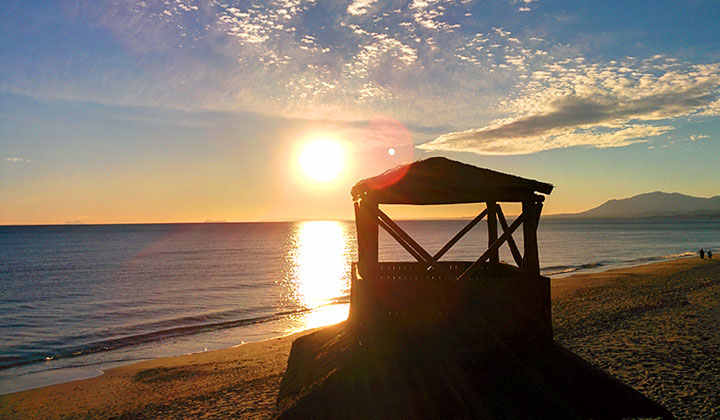
Estepona beaches
Estepona’s beaches are of fine sand, calm, with all the services you need, unique landscapes, where, on clear days, you can see Africa on the other side of the Strait. Estepona has 23 kilometres of coastline divided between more than 15 beaches. Malaga airport to Estepona info.
Manilva beaches
With about 8 kilometres in length, the coast of Manilva stretches along a coastline that ranges from rocky inlets to calm, sandy beaches. They offer clean and crystalline waters and provide all kinds of services distinguished by their quality.
The most relevant Costa del Sol beaches
With more than 120 beaches, on a coastline that extends for more than 150 kilometres, it can be hard to pick the perfect one. To help you, below, we compiled a list with some of the best Costa del Sol beaches with a relevant link to their location on Google Maps (listed from east to west)
- Maro beach – Google Maps
- Burriana beach Nerja – Google Maps
- Torrecilla Beach Nerja – Google Maps
- Playa del Peñoncillo Torrox – Google Maps
- La Caleta beach Vélez Málaga – Google Maps
- Torre del Mar beach – Google Maps
- La Butibamba beach Cala del Moral – Google Maps
- El Palo beach Málaga – Google Maps
- Pedregalejo beach Málaga – Google Maps
- La Malagueta beach Málaga – Google Maps
- La Misericordia beach Málaga – Google Maps
- Carihuela beach Benalmádena – Google Maps
- Torreblanca beach – Google Maps
- Los Boliches beach Fuengirola – Google Maps
- El Castillo beach Fuengirola – Google Maps
- Beach for dogs Fuengirola – Google Maps
- Naturist beach Playamarina – Google Maps
- Calahonda beach – Google Maps
- Cabopino / Artola beach – Google Maps
- Real de Zaragoza beach Marbella – Google Maps
- Alicate beach Marbella – Google Maps
- Los Monteros beach Marbella – Google Maps
- Beach for dogs Marbella – Google Maps
- El Cable beach Marbella – Google Maps
- Bajadilla beach Marbella – Google Maps
- Venus beach Marbella – Google Maps
- Casablanca beach Marbella – Google Maps
- Nagüeles beach Marbella – Google Maps
- Puerto Banus beach Marbella – Google Maps
- San Pedro Alcantara beach Marbella – Google Maps
- Saladillo beach Estepona – Google Maps
- Castor beach Estepona – Google Maps
- Padron beach Estepona – Google Maps
- Rada beach Estepona – Google Maps
- Cristo beach Estepona – Google Maps
- Nudist beach Costa Natura Estepona – Google Maps
- Sabinillas beach Manilva – Google Maps
- Puerto la Duquesa beach Manilva – Google Maps
- Chullera beach Manilva – Google Maps
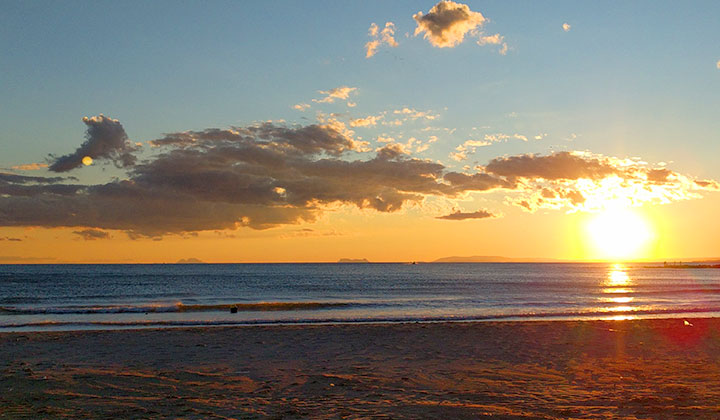
Security tips – What the beach flags mean
- Green flag – Possibly the flag is best known to all and common on the beaches of the Costa del Sol. It means that swimming allowed with good sea conditions.
- Yellow flag – Bathing is allowed but with limitations. People should only bathe when they can touch the bottom and always with their heads out of the water.
- This colour is used to indicate that there is some danger, whether due to contamination, animals, floating elements, etc.
- When there are jellyfish in the sea, it can be accompanied by a specific white flag with two jellyfish.
- Red flag – Indicates people cannot bathe.
Málaga Council recommendations
Find below a series of recommendations (from Málaga the Council) so that a beach day does not end in disgust and possible fines.
- Bathing/washing in the sea: You can not use gel or shampoo to wash in the sea. You can use showers or footbaths, but without soap. Also, you can not wash any kitchen appliances in the sea.
- Vehicles.It is strictly forbidden to circulate or leave any vehicle in the sand. On the other hand, disabled trolleys, if expressly permitted, can circulate and park on the beach.
- Soccer and beach tennis. The Council ordinance advises against annoying sports practices, such as soccer or beach tennis, on small beaches. You can only play on big beaches as long as you keep more than 6 meters distance from people.
- Camping. Camping on the beach is prohibited, such as the use of any stable element to occupy space on the sand. Violators will have to move immediately upon police request.
- Dogs. They are only allowed on dog-friendly beaches
- Fishing. This practice is forbidden between 10 am and 9 pm
- Music. Only with headphones.
- Do not leave trash behind
Covid-19 beach recommendations
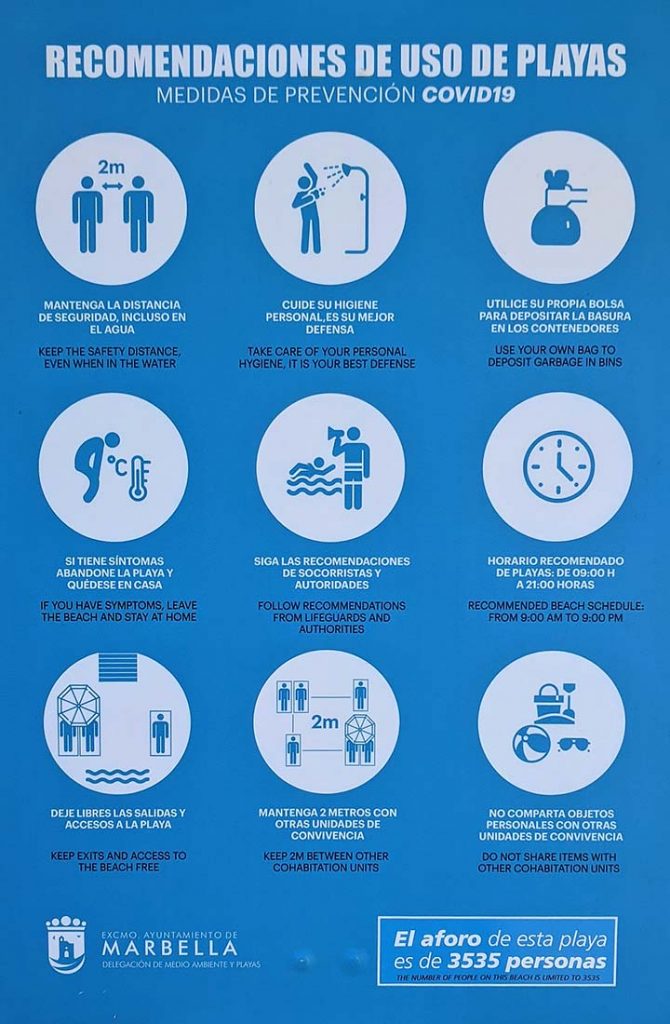
- Keep the safety distance, even when in the water
- Take care of your personal hygiene, it is your best defence
- User your own bag to deposit garbage in the bins
- If you have symptoms, leave the beach and stay at home
- Follow recommendations from lifeguards and authorities
- Recommended beach schedule: from 9:00 am to 9:00 pm
- Keep beach access and exits free at all time
- Keep 2 metres between you and other people
- Do not share items with other people


